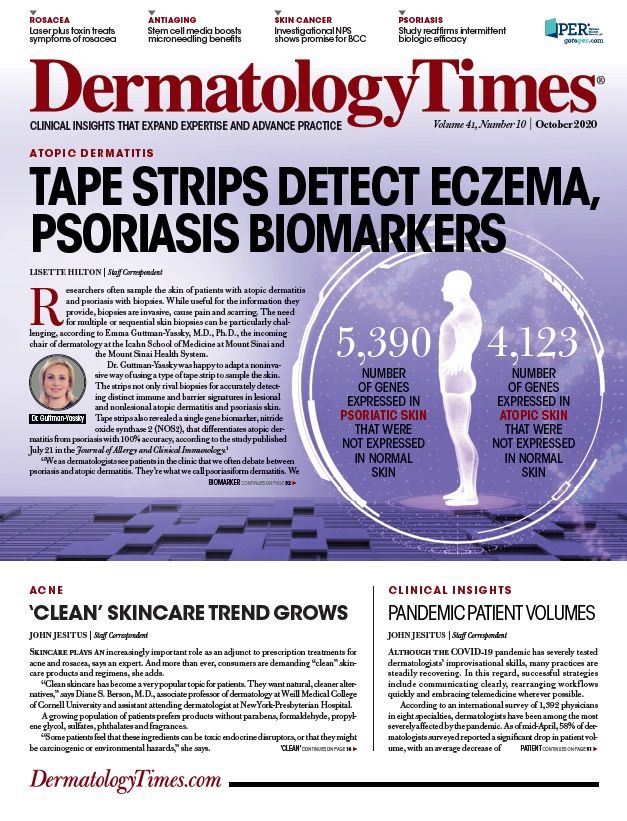- Case-Based Roundtable
- General Dermatology
- Eczema
- Chronic Hand Eczema
- Alopecia
- Aesthetics
- Vitiligo
- COVID-19
- Actinic Keratosis
- Precision Medicine and Biologics
- Rare Disease
- Wound Care
- Rosacea
- Psoriasis
- Psoriatic Arthritis
- Atopic Dermatitis
- Melasma
- NP and PA
- Skin Cancer
- Hidradenitis Suppurativa
- Drug Watch
- Pigmentary Disorders
- Acne
- Pediatric Dermatology
- Practice Management
- Prurigo Nodularis
- Buy-and-Bill
Publication
Article
Dermatology Times
Drug vehicles deliver benefits
Author(s):
Vehicles for topical atopic dermatitis treatments deliver benefits that promote barrier restoration and enhance innate immune defenses, a review suggests.
A recent review concludes that rather than being inert drug carriers, vehicles for topical atopic dermatitis (AD) treatments deliver benefits that promote barrier restoration and enhance innate immune defenses. As such, authors say, dermatologists and drug developers should consider drug-vehicle interaction in therapeutic choices, drug design and clinical trials.
“Vehicles in topical formulations play several important roles that are unique to dermatology,” says Zoe Diana Draelos, M.D., president of Dermatology Consulting Services, PLLC. Vehicles must maintain drug stability, release drugs into the skin and allow them to penetrate in active form, without entering systemic circulation.
The paper, which appeared online July 16 in the Journal of Dermatological Treatment, will impact clinicians, says Dr. Draelos. It will remind them that the vehicle is an active contributor to drug efficacy, and that the formulation should be considered as a whole when selecting the appropriate medication for a patient.1
In the past, she says, developers looked for the cheapest, simplest vehicle they could get approved by the FDA.
“So, the vehicle became a nonparticipant in therapeutic treatment,” she explains.
However, for example, propylene glycol helps maximize topical steroid efficacy.
“The reason is because propylene glycol blows apart the stratum corneum,” she says. “That increases penetration of the drug, but propylene glycol can cause stinging, burning and itching, and it damages the skin barrier.”
A more modern approach might instead use occlusive agents, such as petrolatum, which boosts penetration by hydrating the skin. Alternatively, various carbomers set on the skin’s surface create a film that encourages drug penetration, prevents transepidermal water loss and will not stick to or rub off on clothing.
“When you decrease transepidermal water loss,” she says, “you improve the environment for healing.”
AD is characterized by a broken skin barrier that confers heightened sensitivity which manifests as itching, stinging and burning. Accordingly, says Dr. Draelos, vehicles should be designed to minimize barrier damage and noxious stimuli while effectively delivering the drug.
In topical trials for AD, the vehicle effect can be particularly problematic.
“Often the term placebo is used,” authors write. “However, this is incorrect and misleading given that vehicles/topical controls are often essentially emollients with inherent therapeutic effects.”
These effects include provoking molecular-level changes that boost the skin barrier and immune responses.
Clinical-trial designs often allow concurrent use of emollients with topical medications without considering the emollients’ clinical effects. Dr. Draelos says that this situation makes it impossible to determine whether concomitant use of emollients improves the overall therapeutic effect or masks the effects of drugs delivered in a vehicle.
“One reason why many companies don’t want to make really nice therapeutic vehicles is because it decreases the chances of statistically separating the vehicle from the vehicle plus the active drug,” she says.
This issue is particularly pertinent, she adds, in light of recent phase 3 failures in acne where study drugs failed to separate from vehicle effects.
Different vehicle types can further obscure perceived efficacy. For example, trials of tacrolimus and pimecrolimus appear to show a stronger vehicle effect for the former’s ointment base versus the cream base of the latter. The strength of this response appears to reduce the perceived efficacy of the more potent tacrolimus.
“Given the complexities of the interaction involved,” authors conclude, “perhaps the best solution is to take a holistic approach to topical treatment, where emollient and anti-inflammatory drug combinations are co-developed and tested together against the current standard of topical therapy in clinical practice.”
As Dr. Draelos says, “With the holistic approach, you design the vehicle to optimize the drug. So the vehicle becomes an important part of the formulation and how it performs.”
DISCLOSURE:
Dr. Draelos has received grants from Anacor and has been a researcher for Pfizer.
REFERENCE:
1 Danby SG, Draelos ZD, Gold LFS, et al. Vehicles for atopic dermatitis therapies: more than just a placebo [published online ahead of print, July 16, 2020]. J Dermatolog Treat. 2020;1-14. doi:10.1080/09546634.2020.1789050.







